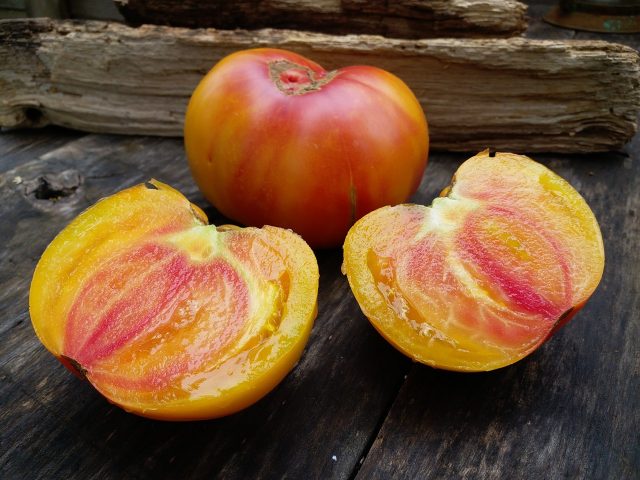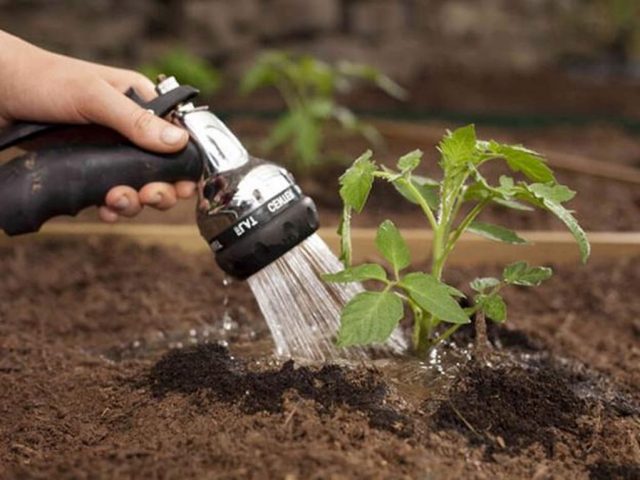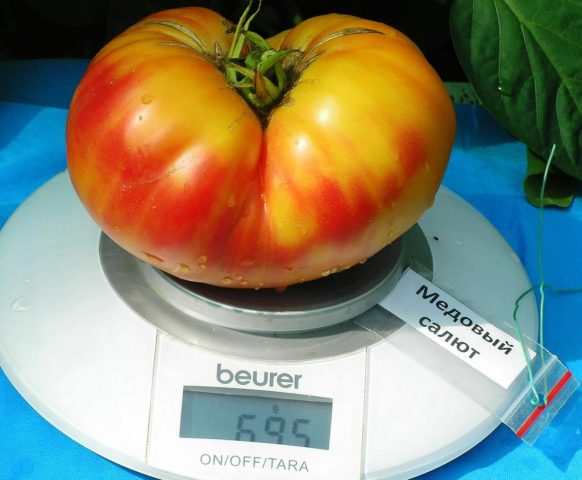Content
Tomato Honey Salute is a relatively new variety, bred in 2004. Tomatoes are suitable for erection in open beds and under a film cover. The bicolor fruit has such a sweet pulp that it is used as a dessert and in fruit salads. Subject to the rules of growing from 1 sq. m you can collect a good harvest.
Description of tomato variety Honey salute
Tomato Honey salute is considered an indeterminate variety (a bush with an unlimited growth rate). Variety characteristics:
- tomatoes of a late ripening period, from sowing for seedlings to removing fruits, it takes about 4 months;
- the plant is tall, reaches a height of 180 cm, so the bush needs support;
- medium leafy variety;
- the first ovary is formed under the 10th leaf, all subsequent ones are formed through every 3th leaf;
- to obtain a bountiful harvest, the plant is grown in 2 stems.
To determine whether a tomato honey salute is suitable or not, you need to read the photos and reviews.
Brief description and taste of fruits
According to gardeners' reviews, the Honey Salute tomato variety fell in love with its beautiful appearance and excellent honey-watermelon taste. At the end of August, large, up to 450 g, rounded-ribbed fruits ripen on the bush. Juicy, dense flesh is covered with a thin orange-red skin with pink or crimson stripes.
In the section, you can see 6 chambers with few, medium seeds. When fully ripe, the tomato pulp acquires a two-color orange-raspberry color.
The fruits are used fresh, for making juices and cold sauces. Tomato variety Honey salute is not suitable for pickling and preserving.
Varietal characteristics
Tomato varieties Honey Salute can be grown in open beds and under a film cover. The cultivation method and yield depend on the climatic conditions, and the length of the warm days:
- in the northern regions - planted in a heated greenhouse;
- in regions with a temperate climate - under a film cover;
- in southern cities, it is permissible to grow the variety in open beds.
According to the description, the Honey Salute tomato is a late-ripening variety. The first crop is harvested 150 days after sowing seeds for seedlings. When grown in 2 stems from 1 sq. m, with timely care, you can remove up to 8 kg of sweet, striped fruits.
Tomato variety Honey salute has no strong immunity to diseases and pests. Therefore, to get rid of winged insects, the bushes are treated with a colloidal solution. To save tomatoes from fungal diseases, the plant is treated with a copper-containing solution. Also, an important role is played by compliance with crop rotation, regular airing and not thickened planting.
Pros and cons of the variety
Tomatoes Honey salute, like any variety, have their positive and negative sides. The pluses include:
- unusual color;
- honey-watermelon taste;
- fruits weigh up to 450 g;
- medium-yielding variety;
- chopped fruits will decorate the festive table.
The disadvantages include:
- late ripening;
- instability to diseases and pests;
- garter and pinching;
- the variety is picky about care.
Planting and care rules
To grow large fruits, you need to plant seeds on time, grow healthy seedlings and take timely care. Compliance with the rules of care is the key to a generous harvest.
Sowing seeds for seedlings
The duration of ripening is influenced not only by varietal characteristics, but also by the timely planting of seeds for seedlings. Since the tomato Honey Salute belongs to the late-ripening varieties, seeds for seedlings are sown from the last days of February to mid-May, it all depends on the quality of the greenhouse and climatic conditions.
Growing tomatoes begins with the preparation of seed. To do this, the seeds are wrapped in cheesecloth and dipped in a weak solution of potassium permanganate for 10 minutes. After the time has elapsed, the seeds in a gauze bag are washed under running water. Disinfected seeds can be dried or put on a damp cloth for germination.
The next stage is soil preparation. For planting tomatoes, light nutritious soil is suitable, made from humus and sod land with the addition of peat or sawdust. Also, seeds can be planted in coconut substrate or peat tablets.
After preparing the seed and soil, you can grow seedlings:
- Sowing seeds is carried out in plastic cups with a drainage hole or in boxes 10 cm high.
- The container is filled with nutrient soil, grooves are made and seeds are planted to a depth of 1 cm.
- The planting material is covered with polyethylene and placed in a warm, bright room. The comfortable temperature for the emergence of sprouts is +2 5 ° С.
- After the sprouts appear, the shelter is removed, and the container is installed under a lamp of additional light. Since the tomato is a light-loving plant, the duration of daylight hours should not be less than 12 hours a day.
- As the soil dries out, the seedlings are watered with warm, settled water.
- After the appearance of 2-3 true leaves, the seedlings are dived in separate pots. If the seeds were planted in separate containers, the pick is carried out in a container of a larger volume.
- 10 days before planting in open ground, the seedlings are hardened, gradually reducing the temperature from + 20 ° C to + 14 ° C degrees. Under the influence of a low temperature, a change in the physiological process occurs, as a result of which the seedlings will quickly take root in a new place.
Transplanting seedlings
Seedlings before planting in a permanent place must meet certain requirements:
- plant height no more than 30 cm;
- the presence of 1 flower brush;
- the presence of short internodes.
To protect the plant from diseases, crop rotation must be observed. Tomatoes are not recommended to be planted after peppers, eggplants and potatoes. Legumes, pumpkins, and crucifers are good precursors for tomatoes.
Tomato seedlings Honey fireworks are planted lying down or at an acute angle. The holes are sprinkled with earth, tamped and spilled.
Planting care
Tomatoes of the Honey Salute variety are demanding for timely care, which consists in feeding, watering, garter and bush formation.
During the season, tomatoes Honey fireworks are fed 3 times:
- 12 days after planting seedlings. For this, nitrogenous fertilizers are used.
- When forming ovaries with a diameter of 1.5 cm on 2 brushes. Apply complex mineral fertilizers.
- During the harvesting of the first fruits. The bushes are fed with phosphorus-potassium fertilizers.
Experienced gardeners advise feeding the bushes with ash infusion or green fertilizer. Tomatoes are thoroughly shed before fertilizing.
Tomatoes of the Honey Salute variety are watered strictly at the root. For each bush, it is necessary to spend at least 2 liters of warm, settled water. After watering, the ground is gently loosened and mulched.The mulch will retain moisture, inhibit the growth of weeds and become an additional organic fertilizer.
Since the honey salute tomatoes grow up to 180 cm and bear fruit up to 450 g, the bush must be tied to a support.
To obtain a generous harvest, tomatoes of the Honey Salute variety are grown in 2 trunks. For this, the stepson formed under the first flower brush is not removed. Later, when 3 fruit brushes appear on it, pinch the top, leaving a few leaves after the last fruits. The pinching of the main trunk is carried out after the formation of the fourth fruit cluster.
Additional care:
- In order for the nutrients to be directed to the formation of fruits, it is necessary to remove the stepsons once a week, leaving a small stump.
- During the ripening of the fruit, the lower leaves are carefully cut off with a sharp secateurs. You can cut no more than 3 leaves from a bush per week. You can also shorten the plate by 1/3 the length.
- To grow large fruits, flower brushes are thinned once a week, removing most of the inflorescences.
- Whole hands and heavy fruits should be tied to prevent bending and breaking.
- Only those fruits that were set before the beginning of August are fully ripe. Therefore, 1.5 months before the final harvest, the top is pinched. After this procedure, watering is reduced, and fertilizing with potash fertilizers is increased.
Conclusion
Tomato Honey salute is one of the most attractive varieties. The appearance of the tomato cannot but please gardeners, and the honey taste will not leave anyone indifferent. If you follow the rules of care and timely prevent diseases, the variety, despite the average yield, will become a frequent guest in greenhouses and open beds.
Reviews of tomato Honey salute













I have been growing a tomato for the second year, last year the first fruits were 1.2 kg each, there is a photo on my page in classmates, the fruit lies at the bottom of an inverted 3 liter jar and its size is larger.